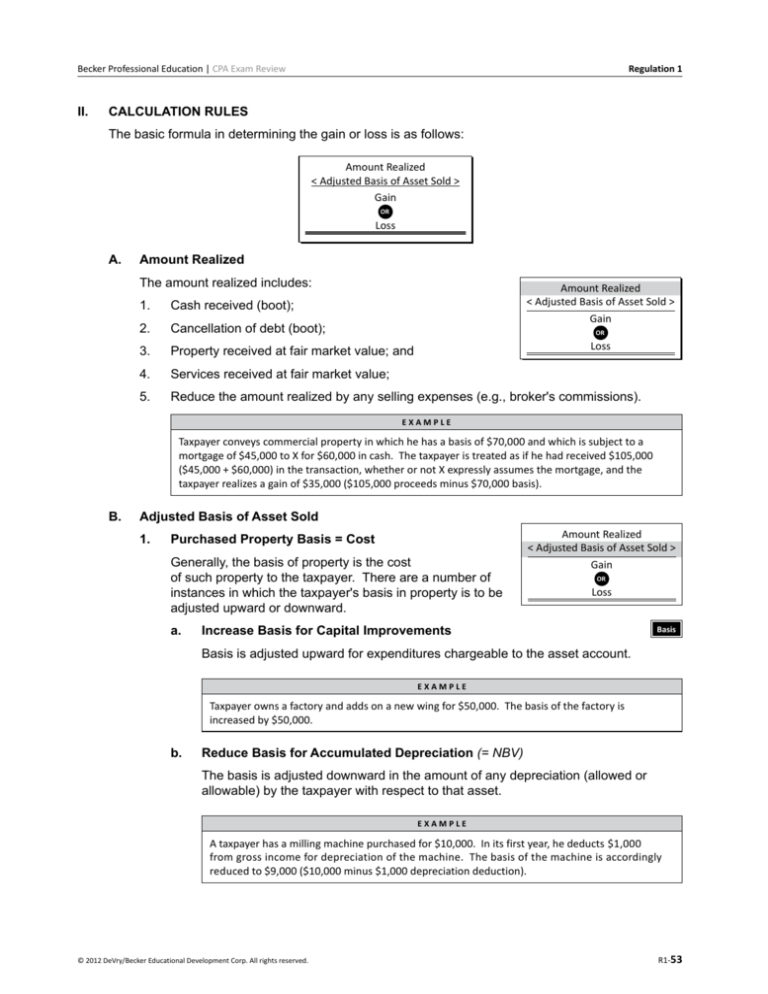
Regulation 1
Becker Professional Education | CPA Exam Review
II.
CALCULATION RULES
The basic formula in determining the gain or loss is as follows:
Amount Realized
< Adjusted Basis of Asset Sold >
Gain
OR
Loss
A.
Amount Realized
The amount realized includes:
1.
Cash received (boot);
2.
Cancellation of debt (boot);
Amount Realized
< Adjusted Basis of Asset Sold >
Gain
OR
Loss
3.
Property received at fair market value; and 4.
Services received at fair market value;
5.
Reduce the amount realized by any selling expenses (e.g., broker's commissions).
Example
Taxpayer conveys commercial property in which he has a basis of $70,000 and which is subject to a
mortgage of $45,000 to X for $60,000 in cash. The taxpayer is treated as if he had received $105,000
($45,000 + $60,000) in the transaction, whether or not X expressly assumes the mortgage, and the
taxpayer realizes a gain of $35,000 ($105,000 proceeds minus $70,000 basis).
B.
Adjusted Basis of Asset Sold
1.
Purchased Property Basis = Cost
Generally, the basis of property is the cost
of such property to the taxpayer. There are a number of
instances in which the taxpayer's basis in property is to be
adjusted upward or downward.
a.
Amount Realized
< Adjusted Basis of Asset Sold >
Gain
OR
Loss
Increase Basis for Capital Improvements
Basis
Basis is adjusted upward for expenditures chargeable to the asset account.
Example
Taxpayer owns a factory and adds on a new wing for $50,000. The basis of the factory is
increased by $50,000.
b.
Reduce Basis for Accumulated Depreciation (= NBV)
The basis is adjusted downward in the amount of any depreciation (allowed or
allowable) by the taxpayer with respect to that asset.
Example
A taxpayer has a milling machine purchased for $10,000. In its first year, he deducts $1,000
from gross income for depreciation of the machine. The basis of the machine is accordingly
reduced to $9,000 ($10,000 minus $1,000 depreciation deduction).
© 2012 DeVry/Becker Educational Development Corp. All rights reserved.
R1-53
Regulation 1
Becker Professional Education | CPA Exam Review
c.
"Spreading" Adjustments
Although most adjustments require an increase or decrease in the basis, some
spread the basis.
Example
Under the IRC, the receipt of a nontaxable stock dividend will require the shareholder to
spread the basis of his original share over both the original shares and the new shares received
resulting in the same total basis, but a lower basis per share of stock held.
2.
Gifted Property Basis for Gain/Loss Purposes
a.
General Rule—Donor's Rollover Cost Basis
Property acquired as a gift generally retains the rollover cost basis as it had in
the hands of the donor at the time of the gift. Basis is increased by any gift tax
paid that is attributable to the net appreciation in the value of the gift. Gains and
losses are calculated using this rollover cost basis (subject to the exception
noted below).
b.Exception—Lower FMV at Date of Gift
If the fair market value at date of gift is lower than the rollover cost basis from the
donor, the basis for the donee depends upon the donee's future selling price of
the asset.
(1) Sale of Gifts at Price Greater than Donor's Rollover Basis (gain basis)
When a taxpayer sells a gift for greater than the rollover basis, the gain
shall be the difference between the sale price and that rollover basis.
Example
Donor gives nondepreciable property worth $3,000 and having an adjusted basis of
$5,000 to taxpayer, who subsequently sells the property for $6,500. The taxpayer's gain
will be $1,500 ($6,500 proceeds minus $5,000 basis).
(2) Sale of Gift at Price Less than Lower Fair Market Value (loss basis)
When a taxpayer sells the gift for less than the lower FMV at the date of
gift, the basis of the gift for purposes of determining the loss is the fair
market value of the gift at the time the gift was given.
Example
Donor gives property worth $3,000 having an adjusted basis of $5,000 to taxpayer who
subsequently sells the property for $1,000. The taxpayer's loss will be $2,000 ($3,000
FMV at date of gift minus $1,000). (Note that the loss may or may not be deductible on
the taxpayer's income tax return, depending on the situation.)
(3) Sale Less than Rollover Cost Basis but Greater than Lower Fair
Market Value (in the middle)
When a taxpayer sells a gift for a price less than the donor's rollover cost
basis, but more than the lower fair market value at the date of gift, neither
gain nor loss is recognized. The basis to the donee is the "middle" selling
price.
R1-54
© 2012 DeVry/Becker Educational Development Corp. All rights reserved.
Regulation 1
Becker Professional Education | CPA Exam Review
c.
Gifted Property Depreciation Calculation
Regardless of the basis for the gain/loss (which may not be known at the time
depreciation is to begin), the basis for depreciation purposes (if applicable) is the
lesser of (i) the donor's adjusted basis at the date of gift or (ii) the fair market
value at the date of gift. The amount of accumulated depreciation will then
reduce the taxpayer's basis calculated for gain/loss purposes (per above) before
the actual gain or loss on the sale is determined.
Example
A donor gives property worth $3,000 and having an adjusted basis of $5,000 to a taxpayer.
• For purposes of determining gain on the sale, the taxpayer's basis is $5,000.
• For purposes of determining loss on the sale, the taxpayer's basis is $3,000.
• If the taxpayer subsequently sells the property for $3,500, there is no gain or loss on the
sale, and the basis is $3,500
• For purposes of calculating depreciation on the asset (if applicable) prior to the sale, the
depreciable basis is $3,000.
Pa s s K e y
• Sell higher Use "donor's basis" to determine gain.
• Sell between
No gain or loss
• Sell lower
Use "lower FMV at date of gift" to determine loss.
Donor Basis
Lower FMV at
Date of Gift
d.
Holding Period
The recipient of the gift normally assumes the donor's holding period. However,
under the exception above, if fair market value at the time of gift is used (loss
basis) as the basis of the gift, the holding period starts as of the date of the gift
(see situation 3 below).
Example
B a s i s o f G i f t e d s t o c k a n d g a i n or l o s s o n re s a l e
General Rule:
FMV Higher
Exception: FMV Lower
1
2
3
4
$20,000
$20,000
$20,000
$20,000
FMV at gift date
40,000
13,000
13,000
13,000
Nephew's selling price
"Basis" to nephew for
gain/loss purposes
30,000
25,000
10,000
15,000
20,000
20,000
13,000
15,000
Taxable gain (if any)
10,000
5,000
Donor's (rich uncle)
basis
Deductible loss (if any)
© 2012 DeVry/Becker Educational Development Corp. All rights reserved.
-03,000
-0-
R1-55
Regulation 1
Becker Professional Education | CPA Exam Review
3.
Inherited Property Basis
a.
General Rule—Date of Death FMV Becomes Basis
Property acquired by bequest or inheritance generally takes as its basis the step-up
(or step-down) to the fair market value at the date of the decedent's death.
b.
Alternate Valuation Date
If validly elected by the executor, the fair market value on the alternate valuation
date (the earlier of 6 months later or the date of distribution/sale) may be used to
value all of the estate property. The alternate valuation date is only available if
its use lowers the entire gross estate and estate tax (although individual assets
may go up or down during the period). [Note: Estate taxation is covered in detail
in Lecture R4.]
If the alternate valuation date is validly elected, the asset is valued using FMV at
the earlier of:
(1) Distribution date of asset; or
(2) Alternate valuation date (earlier of 6 months after death or date of
distribution/sale).
Example
Testator died owning property worth $60,000 and in which he had a basis of $20,000. His son
inherited the land and subsequently sold it for $55,000. The son will recognize a loss of $5,000
($60,000 basis minus $55,000 proceeds). The gain inherent in the property at the time of the
testator's death goes unrecognized.
c.
Holding Period
Property acquired from a decedent is automatically considered to be long-term
property regardless of how long it actually has been held.
E x a m p l e B ASIS O F IN H E R IT E D P R O P E R TY ( y e a r s a f t e r 2 0 1 0 )
1. Assume a taxpayer inherited property from a decedent. The FMV at date of death was
$20,000. The property was worth $15,000 six months later, and was worth $22,000 when it
was distributed to the taxpayer eight months later. It had a cost basis to the deceased of
$5,000.
What is the basis of inherited property to the taxpayer:
a. If the alternate valuation date was not elected?
$20,000
b. If the alternate valuation date was elected?
$15,000
2. Assuming the beneficiary sold that property for $25,000, compute the capital gain:
a. Assuming the alternate valuation date was not elected.
b. Assuming the alternate valuation date was elected.
R1-56
$5,000 = 25,000 – 20,000
$10,000 = 25,000 – 15,000
© 2012 DeVry/Becker Educational Development Corp. All rights reserved.
Regulation 1
Becker Professional Education | CPA Exam Review
Pa s s K e y
re a l i z e d * , b u t n o t re c og n i z e d , g a i n s or l o s s e s
AMOUNT REALIZED
Money Received
(boot)
C.O.D.
(boot)
FMV Property
Less: Selling Expenses
Purchase = Cost
< ADJUSTED BASIS OF ASSET SOLD >
Gift = Rollover Cost
Inherited = Step-up FMV
Homeowners Exclusion
Involuntary Conversion
GAIN
Divorce Property Settlement
Exchange of Like Kind (Business)
Installment Sale
Treasury Capital & Stock
OR
Wash Sale Losses
LOSS
Related Party Losses
And
Personal Losses
* All realized gains and losses are recognized (i.e., reported on the tax return) unless "HIDE IT" or "WRaP" applies.
© 2012 DeVry/Becker Educational Development Corp. All rights reserved.
R1-57







